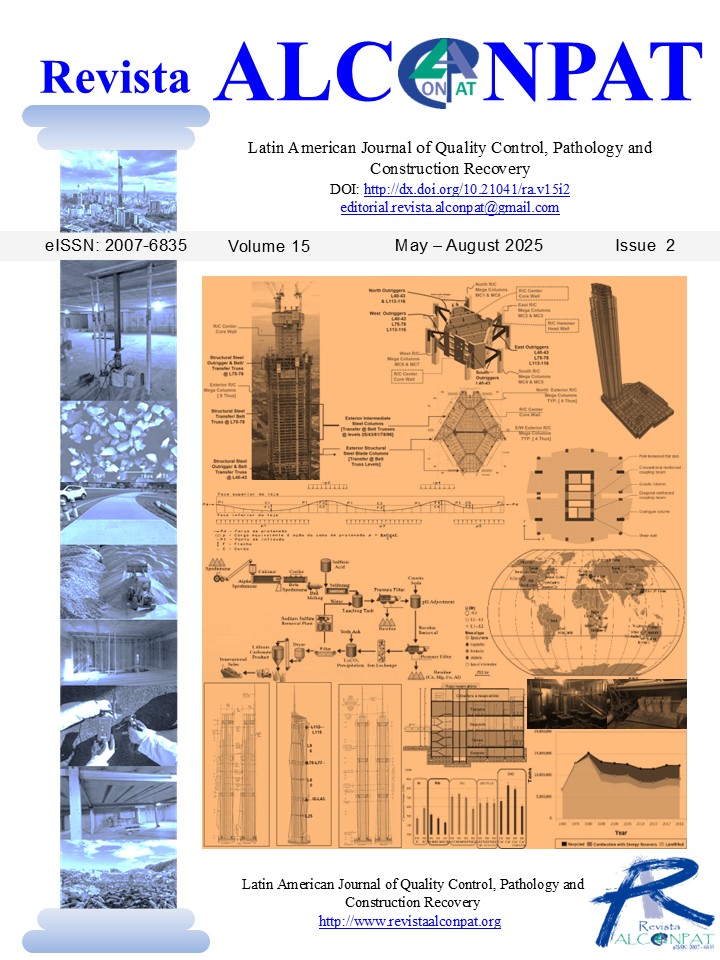Service life evaluation in concrete rehabilitation – a sustainability benefit.
DOI:
https://doi.org/10.21041/ra.v15i2.814Keywords:
concrete repair, concrete sustainability, structural assessment, nondestructive testing, service lifeAbstract
This paper discusses several repair design and maintenance practices to produce durable and sustainable concrete structures. Emphasis is given in the assessment and evaluation of deteriorated concrete structures. The evaluation and repair principles are demonstrated through case studies of deteriorated concrete structures. Concrete preservation is an important consideration to sustain both economic and natural resources. Concrete, like almost any other building material, is susceptible to deterioration during its service life. Repairing and extending the service life of concrete structures contributes to overall sustainability of materials and resources. Assessment and repair decisions should be based on a thorough evaluation consisting of visual inspection, nondestructive Testing (NDT), laboratory testing, and a service life evaluation analysis.
Downloads
References
AIA Document D503 (2013), “Guide for Sustainable Projects,”, American Institute of Architects, Washington, DC, 20120, 67 pp.
ICRI Committee 160 (2015), Life Cycle and Sustainability, Sustainability for Repairing and Maintaining Concrete and Masonry Buildings, 13 pp.
ACI Committee 364 (2020), “Guide for Evaluation of Concrete Structures before Rehabilitation (ACI 364.1R-20),” American Concrete Institute, Farmington Hills, Michigan, 24 pp.
ACI Committee 562 (2019), “Code Requirements for Evaluation, Repair, and Rehabilitation of Existing Concrete Structures and Commentary (ACI 562-19),” American Concrete Institute, Farmington Hills, Michigan ,94 pp.
ACI Committee 201 (2008), “Guide for Conducting Visual Inspection of Concrete in Service (ACI 201.1R- 08),” American Concrete Institute, Farmington Hills, Michigan, 15 pp.
ACI Committee 224 (2007), “Causes, Evaluation and Repair of Cracks in Concrete (ACI 224.1R-07),” American Concrete Institute, Farmington Hills, Michigan, 22 pp.
ACI Committee 228 (2013), “Report on Nondestructive Test Methods for Evaluation of Concrete Structures (ACI 228.2R-13),” American Concrete Institute, Farmington Hills, Michigan, 82 pp.
ACI Committee 546R (2023), “Guide to Concrete Repair (ACI 546R-23),” American Concrete Institute, Farmington Hills, Michigan, 59 pp.
ACI Committee 563 (2019), “Specifications for Repair of Concrete in Buildings (ACI 563-18)” American Concrete Institute, Farmington Hills, Michigan, 40 pp.
ICRI No. 210.4 (2021) Guide for Nondestructive Evaluation Methods for Condition Assessment, Repair, and Performance Monitoring of Concrete Structures, 28 pp.
ICRI No. 310.1R (2008) Guide for Surface Preparation for the Repair of Deteriorated Concrete Resulting from Reinforcing Steel Corrosion, 8 pp.
ACI Committee 318 (2019) “Building Code Requirements for Structural Concrete and Commentary (ACI 318-19),” American Concrete Institute, Farmington Hills, Michigan, 623 pp.
Published
How to Cite
Issue
Section
License
_______________________________
License in effect from September 2020
You are free to:
- Share — copy and redistribute the material in any medium or format for any purpose, even commercially.
- Adapt — remix, transform, and build upon the material for any purpose, even commercially.
- The licensor cannot revoke these freedoms as long as you follow the license terms.
Under the following terms:
- Attribution — You must give appropriate credit , provide a link to the license, and indicate if changes were made . You may do so in any reasonable manner, but not in any way that suggests the licensor endorses you or your use.
- No additional restrictions — You may not apply legal terms or technological measures that legally restrict others from doing anything the license permits.
Notices:
You do not have to comply with the license for elements of the material in the public domain or where your use is permitted by an applicable exception or limitation .
No warranties are given. The license may not give you all of the permissions necessary for your intended use. For example, other rights such as publicity, privacy, or moral rights may limit how you use the material.





















.png)














